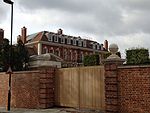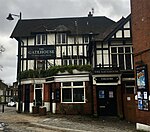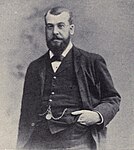5, The Grove

5, The Grove is a semi-detached house in Highgate, London. It is listed Grade II on the National Heritage List for England.Originally built around 1688, it was rebuilt around 1933 by C. H. James, yet retained its general appearance. The house consists of 3 storeys with a basement, built in red brick. The interior has been substantially altered since it was built. During James's remodeling of the house in the 1930s, several examples of early 18th-century wallpapers were found hidden behind wooden paneling, which were subsequently donated to the Victoria and Albert Museum. Wooden railings surround the front of the house, and a lantern surmounts the front entrance. Prior to his death in 2016, George Michael was the sole tenant of this building.
Excerpt from the Wikipedia article 5, The Grove (License: CC BY-SA 3.0, Authors, Images).5, The Grove
The Grove, London Dartmouth Park (London Borough of Camden)
Geographical coordinates (GPS) Address External links Nearby Places Show on map
Geographical coordinates (GPS)
| Latitude | Longitude |
|---|---|
| N 51.57 ° | E -0.1519 ° |
Address
The Grove 5
N6 6JU London, Dartmouth Park (London Borough of Camden)
England, United Kingdom
Open on Google Maps







